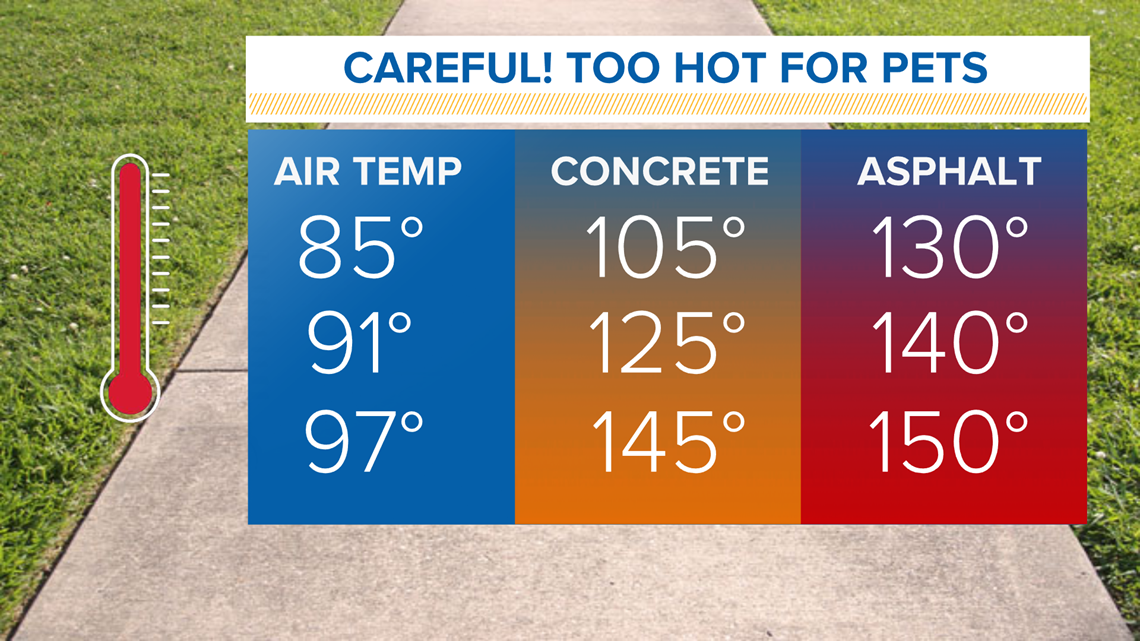You may have noticed that it has been very hot outside lately. We are all currently under an extreme heat warning, including our furry friends. Since summer has just started we must keep in mind, that if it’s hot outside for us then its even hotter for our pets. We have the ability to wear shorts, tank tops, T-shirts, flip flops, and so much more to help regulate our body temperature. Unfortunately, our pets don’t have that same courtesy. The primary way pets stay cool is by being in the shade, staying hydrated, and panting. With the heat it is possible for your cat to also start panting as a result. If possible for our dog breeds with particularly thick coats it is important to take them to the groomers and keep their coats short during the summertime to help them beat the heat! When outside with your pets remember to bring water and have spaces for them to take breaks and lay in the shade to help them stay cool, or just leave them at home! Yes, it is fun to bring our pets on adventures with us, but during extreme heat you could be putting their lives a jeopardy. Keeping them indoors with the AC will ensure there is no risk for heat stroke or exhaustion. AC is especially important when your pet is in the car; No, cracking your window is not enough to keep your pet cool, if anything the car will become the same temperature as outside and even hotter! During the summertime a car can reach up to over 100 degrees Fahrenheit in as little as 30minutes. It is important to keep the AC on with the windows up to ensure that there is good airflow and that cool air is getting trapped in the car and not escaping.
Although we recommend keep your pets indoors during this heat wave, we understand that there is still the possibility you may take them outdoors. If you must have your friend outdoors with you make sure you do it during the cooler parts of the day like during the morning or at night. When walking with your pet make sure you stay off of surfaces such as asphalt or concrete because they soak up the heat from the sun and could potentially harm your pet. During the summertime asphalt easily reach up to 125°F to 140°F and even higher fairly quickly, it is important to check our chart provided to see at what degree the asphalt/concrete is before deciding to take your pet out. Make sure you bring water for your pet and allow time for breaks. When your pet is outside it is important to watch for signs of heat stroke, especially in our overweight pets and brachycephalic animals. Brachycephalic dogs are the short-nosed dog breeds which have difficulty breathing due to the anatomy of their airways. These brachycephalic breeds are Boston Terrier, French Bulldog, Lhasa Apso, Pug, Brussels Griffon, Pekinese, Shih Tzu, Bull Mastiff, Chinese Shar-Pei, Boxer, English Bulldog, Australian Bulldog, Dogue De Bordeaux, and Chow Chow. Since these dog breeds have a shortened skull structure this makes it difficult to breath regularly which makes panting more challenging, meaning they have a harder time cooling down. These dogs are at an increased risk for heat stroke and stress and should be kept in doors with the AC, especially with the ongoing heat advisory.
Now, we know who is more at risk for heat stroke and ways to prevent it, but what are the signs? Heat stroke can cause rapid breathing, heavy panting, weakness (collapse or stumbling), drowsiness, confusion, vomiting, diarrhea, and abnormally colored gums (red) that can feel sticky to the touch. These signs are seen alongside dehydration, a fast heart rate, elevated temperature, seizures, and possibly death. The normal BPM (beats per minute) for a dog’s heart should be 120-160 in puppies, 100-140 in small dogs less than 30 pounds, 60-100 in medium dogs around 30-70 pounds, and 50-80 in large dogs over 70 pounds. The BPM can be calculated by counting each cardiac cycle within 15 seconds and multiplying by four, or counting the cycle for a minute. With temperature, we use rectal thermometers partnered with lube in order to calculate temperate; it would be a wonderful idea to purchase these tools in order to monitor temperature while outdoors. Your dog should be in between 101 and 102.5 degrees Fahrenheit, if over heed caution and cool your pet; 104 degrees Fahrenheit is considered a medical emergency. Another way you can tell if your animal is hot is by touching the gum line and seeing if it is hot to the touch. If you suspect your dog is dealing with heat stroke you must see the veterinarian immediately. There are a number of emergency clinics in Sioux Falls that will be able to assist you. While on the way to the vet make sure your pet is out of direct sunlight and try to cool them down. Cooling can be done in a number of different ways by placing a cool towel on the dog’s head, neck, feet, chest and abdomen, by putting a fan on your dog, bringing your dog into the AC, and by apply isopropyl alcohol on the feet pads in small quantities. When cooling your pet down keep in mind that you must do this slowly but surely, after trying different methods of cooling make sure you are retaking the temperature every 10-15 minutes to monitor. Once 103 degrees Fahrenheit stop the cooling process because the body will continue to cool on its own and could become dangerously low alongside cooling techniques. When dealing with any heat crisis make sure pet is seen by the veterinarian so vitals can be taken and can be interpreted by a medical professional.

